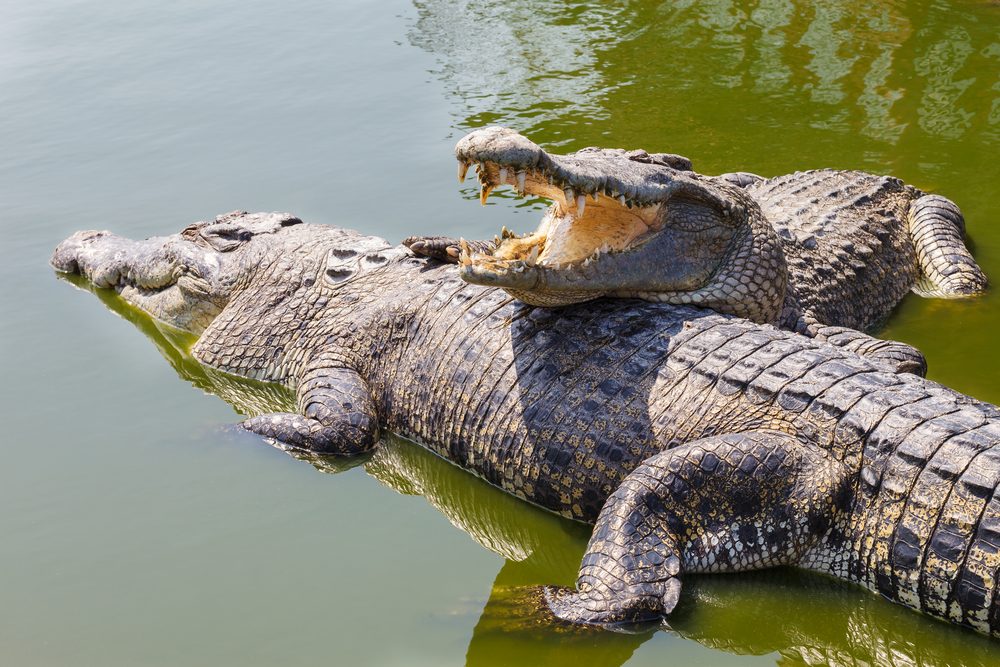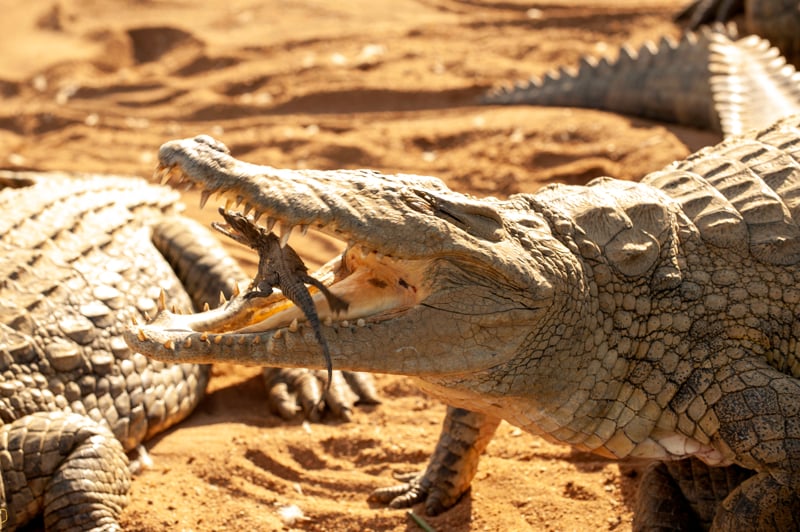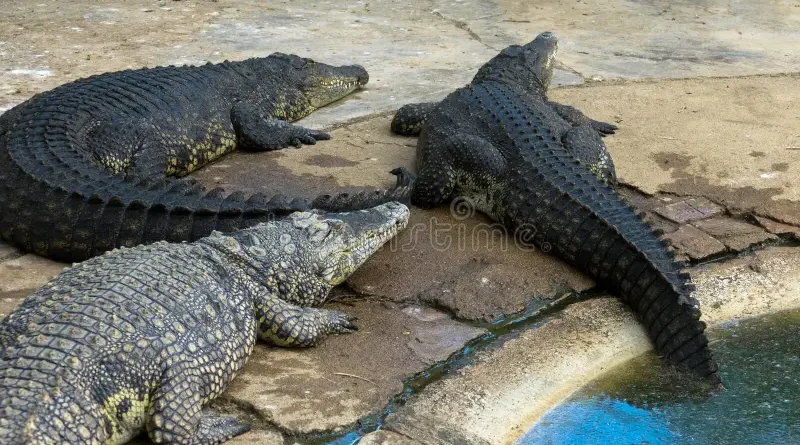Nile Crocodile Breeding in Captivity
Nile Crocodile Breeding in Captivity The Nile crocodile (Crocodylus niloticus) is one of the most well-known species of crocodiles, inhabiting freshwater bodies across Africa, from rivers and lakes to marshes. These formidable reptiles play a crucial role in their ecosystems, acting as apex predators and contributing to the balance of aquatic life. Unfortunately, due to habitat loss, poaching, and human-wildlife conflict, Nile crocodile populations have faced significant threats, leading to the need for conservation efforts. Breeding Nile crocodiles in captivity not only supports conservation initiatives but also offers opportunities for research, education, and economic benefits, particularly in the sustainable farming of crocodile products.
Breeding Behavior in the Wild

Understanding the natural breeding behavior of Nile crocodiles is essential for successful captive breeding. During the breeding season, male crocodiles engage in elaborate courtship displays, including vocalizations and physical displays to attract females. Once a pair has formed, they seek suitable nesting sites, often near water, where the female constructs a nest using vegetation and mud.
Here’s a table summarizing key aspects of Nile crocodile breeding in captivity:
| Category | Key Points |
|---|---|
| Breeding Season | Late spring to summer; monitor environmental conditions. |
| Breeding Stock Health | Regular health assessments and disease screenings; balanced diet. |
| Egg Laying | 20 to 60 eggs per clutch; varies based on individual conditions. |
| Incubation Temperature | 28°C to 32°C (82°F to 90°F); humidity around 80-90%. |
| Hatchling Diet | High-protein foods: small fish, insects, specialized pellets. |
| Stress Reduction | Provide spacious habitats, hiding spots, and minimize disturbances. |
| Common Diseases | Respiratory infections, skin diseases, parasites. |
| Hatching Period | 70 to 90 days; signs include pipping and visible cracks. |
| Natural Breeding | Possible without hormonal manipulation if conditions are optimal. |
| Ethical Considerations | Ensure health, prioritize conservation, adhere to regulations. |
| Conservation Contribution | Replenish wild populations, support research and education. |
| Signs of Health | Clear eyes, smooth skin, active behavior, robust appetite. |
| Reintroduction | Requires careful planning and monitoring post-release. |
| Further Learning | Workshops, scientific literature, expert collaboration, site visits. |
This table provides a quick reference for important information regarding the breeding of Nile crocodiles in captivity, covering various aspects from breeding practices to health considerations.
Nile crocodiles typically lay between 20 to 60 eggs per clutch, depending on the size and age of the female. The incubation period lasts approximately 70 to 90 days, during which the female guards the nest to protect it from predators. After hatching, the female assists the hatchlings to water, providing some level of parental care, which significantly increases their chances of survival.
Captive Breeding Techniques
To successfully breed Nile crocodiles in captivity, several factors must be considered:
A. Selecting Breeding Stock
Choosing genetically diverse and healthy breeding stock is vital to ensure strong offspring. Genetic assessments can help maintain diversity and reduce inbreeding, which can lead to health issues in the population.
B. Environmental Requirements

Creating an optimal habitat for captive breeding is crucial. This includes:
- Habitat Setup: Enclosures must mimic natural conditions, with appropriate temperature and humidity levels. Nile crocodiles thrive in warm environments, typically between 25°C to 35°C (77°F to 95°F).
- Enclosure Design: The enclosures should be spacious and incorporate both land and water areas to allow natural behaviors. Additionally, the materials used should ensure safety and prevent escapes.
C. Breeding Protocols
Effective breeding protocols involve monitoring the crocodiles closely. In some cases, hormonal manipulation can stimulate breeding behaviors. Timing is critical, and breeding efforts should align with the natural breeding season to increase success rates.
Egg Incubation and Hatching
A. Artificial Incubation Methods
When eggs are laid, they can be moved to controlled environments for incubation. Key methods include:
- Incubators: These devices allow for precise control of temperature and humidity, essential for the successful development of crocodile eggs.
- Monitoring Conditions: Regular checks are necessary to maintain optimal conditions and ensure healthy embryo development.
B. Hatching Process
The hatching period can vary, with eggs typically hatching after 70 to 90 days. Signs that eggs are ready to hatch include pipping sounds and visible cracks in the shell. Upon hatching, the hatchlings require immediate care to ensure their survival.
Rearing Hatchlings

Proper care of hatchlings is crucial for their development:
A. Initial Care Requirements
- Feeding: Hatchlings require a diet rich in protein, typically consisting of small fish, insects, and specialized hatchling pellets. Regular feeding is essential for growth and health.
- Habitat Needs: Maintaining appropriate temperatures and providing secure shelters are vital in the rearing phase.
B. Growth and Development
Monitoring growth and developmental milestones helps ensure that hatchlings thrive. Regular veterinary checks can help identify any health issues early, allowing for timely interventions.
Challenges and Considerations
While breeding Nile crocodiles in captivity has many benefits, challenges exist:
A. Disease Management
Preventing disease outbreaks through regular health checks and proper hygiene practices in enclosures is essential.
B. Behavioral Issues

Crocodiles may display stress-related behaviors in captivity, including aggression. Providing enrichment and socialization opportunities can help mitigate these issues.
C. Ethical Considerations
Breeding for profit raises ethical questions about animal welfare. Ensuring that breeding practices prioritize the health and well-being of the crocodiles is essential.
Success Stories and Case Studies
Numerous captive breeding programs have successfully contributed to Nile crocodile conservation:
A. Notable Programs
Programs such as the Nile Crocodile Breeding Project in Zimbabwe have demonstrated the potential of captive breeding to bolster wild populations and educate the public about crocodile conservation.
B. Innovations in Practices
The use of advanced incubation technologies and genetic management strategies has improved breeding success rates and enhanced genetic diversity among captive populations.
Conclusion
Breeding Nile crocodiles in captivity plays a vital role in conservation efforts, contributing to the recovery of wild populations and enhancing our understanding of these remarkable reptiles. As we look to the future, continued research and investment in captive breeding programs are essential to ensure the survival of Nile crocodiles and their ecosystems. Supporting initiatives that prioritize ethical breeding practices and conservation can help secure a future for these magnificent creatures.
Tips for Breeding Nile Crocodiles in Captivity
Understand Natural Behaviors:
- Study the natural mating rituals, nesting habits, and parental care of Nile crocodiles to create an environment that mimics their wild behavior.
Select Healthy Breeding Stock:
- Choose genetically diverse and healthy individuals to ensure robust offspring. Conduct health screenings and genetic assessments before breeding.
Create Optimal Habitat:
- Design enclosures that replicate natural habitats. Include:
- Temperature Control: Maintain temperatures between 25°C to 35°C (77°F to 95°F).
- Water and Land Areas: Provide both to facilitate natural behaviors, including basking and swimming.
Monitor Environmental Conditions:
- Regularly check temperature, humidity, and water quality to create a suitable environment for breeding and egg incubation.
Implement Proper Breeding Protocols:
- Use controlled breeding techniques, including monitoring hormonal changes in females to optimize the timing of breeding efforts.
Manage Egg Incubation Carefully:
- If using artificial incubation:
- Set up a reliable incubator with temperature and humidity controls.
- Turn the eggs gently and regularly to ensure even development.
Provide Immediate Care for Hatchlings:
- After hatching, ensure that hatchlings have access to:
- Shelter: Safe hiding spots to reduce stress.
- Nutrition: A high-protein diet, such as small fish and specialized pellets, to promote healthy growth.
Monitor Growth and Health:
- Regularly assess the health and development of hatchlings. Keep a record of their growth rates and any health issues to address them promptly.
FAQs on Nile Crocodile Breeding in Captivity
What is the optimal breeding season for Nile crocodiles?
- The breeding season for Nile crocodiles typically occurs during the warm months, usually from late spring to summer, depending on the geographical location. It’s important to monitor environmental conditions and mimic natural seasonal changes in captivity.
How can I ensure the health of breeding stock?
- Conduct regular health assessments, including physical examinations and disease screenings. Provide a balanced diet, proper habitat conditions, and minimize stress to maintain the overall health of breeding stock.
What should be the ideal temperature for egg incubation?
- Nile crocodile eggs should be incubated at a temperature of approximately 28°C to 32°C (82°F to 90°F) for optimal development. Monitoring humidity levels (around 80-90%) is also crucial for successful hatching.
How many eggs do Nile crocodiles typically lay?
- Female Nile crocodiles usually lay between 20 to 60 eggs per clutch, depending on their age and health. The number can vary based on environmental factors and individual conditions.
What should I feed hatchlings?
- Hatchlings require a diet high in protein. Suitable food includes small fish, insects, and specially formulated hatchling pellets. Feed them multiple times a day to ensure proper growth and health.
How can I reduce stress in captive crocodiles?
- Provide a spacious and enriched habitat with hiding spots, basking areas, and varied substrates. Minimizing disturbances and maintaining a consistent routine can also help reduce stress.
What common diseases affect captive Nile crocodiles?
- Common diseases include respiratory infections, skin diseases, and parasites. Regular health checks and proper hygiene practices can help prevent outbreaks.
How long does it take for Nile crocodile eggs to hatch?
- The incubation period for Nile crocodile eggs is generally between 70 to 90 days, depending on temperature and humidity conditions. Signs of impending hatching include pipping sounds and visible cracks in the eggs.
